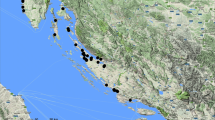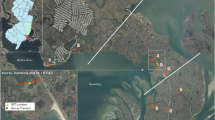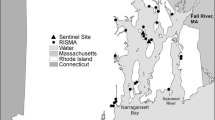Abstract
The objective of this study was to understand the main factors controlling salt marsh plant species structure and dynamics. So, we determined plant cover and composition across a permanent transect, 450 m long and 1 m wide, defined in 1951 in Corroios salt marsh, in the Tagus estuary (Portugal) and we characterized the physicochemical variables every 50 m along this transect. Based on those results we discuss the dynamic and evolution of salt marsh vegetation during the last 50 years comparing former and recent data. The results showed that differences in salinity and flooding were determinant factors in plant species composition and distribution along the studied transect. In addition, long-term variations of these factors as a consequence of vertical accretion and sea level rise seem to be responsible for the evolution in plant structure and vegetation zonation patterns, during the last 50 years in the Tagus estuary salt marshes.
Similar content being viewed by others
Explore related subjects
Discover the latest articles, news and stories from top researchers in related subjects.Avoid common mistakes on your manuscript.
Introduction
The vegetation of salt marshes is often exposed to extreme environmental conditions. Consequently, salt marshes are characterized by low flora diversity and by species occurring in distinct vegetation zones (Woerner & Hackney, 1997).
The zonal distribution of higher plants in salt marshes has been studied extensively for over a century, but the mechanisms generating the segregation of salt marsh plant species is poorly understood. Most of the work trying to explain the vertical distribution of plant species on salt marshes has been focused on the role of abiotic factors (Rogel et al., 2000). In general, salinity and flooding are repeatedly mentioned as the main environmental factors governing species zonation. Recently, competitive ability and physiological tolerance were also considered as important driving factors, as well as anthropogenic factors. Nitrogen levels may also affect salt marsh plant diversity (Valiela & Teal, 1979). Several authors have addressed the question whether plant succession in salt marsh ecosystems can be studied on their basis of the zonation pattern. It is likely that salt marshes with high accretion rates feature a zonation that indeed represents a successional series. However, the vegetation pattern in salt marshes with low accretion rather reflects the variation in the geomorphology of the soil (Roozen & Westhoff, 1985; Leeuw et al., 1993). The concept of chronosequence has become very important in the experimental approach to the study of mechanisms of succession (Wijnen, 1999).
The Tagus estuary is one of the largest estuaries in the European Atlantic coast, covering an area of 320 km2. The southern and eastern parts of the estuary contain extensive intertidal mudflat areas with the presence of Spartina maritima (Curtis) Fernald, (Poaceae), Halimione portulacoides (Linnaeus) Aellen, Sarcocornia fruticosa (Linnaeus) Scott and Sarcocornia perennis (Miller) A. J. Scott.
In order to understand the main factors controlling plant zonation we characterize the physicochemical variables across a permanent transect in the Corroios salt marsh. Based in those results we discuss the dynamics of salt marsh vegetation during the last 50 years, comparing historical and recent zonation patterns data.
Materials and methods
A transect 450 m long and 1 m wide was established to represent the main vegetation areas in Corroios salt marsh (38°39′ N 09°08′ W) (Fig. 1). Sampling was conducted every 2 months between March 2002 and March 2003. Floristic composition and species abundance were determined based on visual estimation of species cover using the Braun-Blanquet abundance scale (Braun-Blanquet, 1979). Sampling stations were established every 50 m. In each station, temperature, redox potential (Eh) and salinity were determined in the sediment between roots. Redox potential (Eh) was measured using a Crison pH/mV meter. Salinity in pore water was determined with a hand refractometer (Atago, S/Mill-E). For each area and sampling period, mean values of temperature, Eh and salinity were determined based on five independent measurements registered within the same area.
Differences in environmental variables according to plant species were evaluated by analysis of variance, using the Statistica software. Whenever null hypotheses were rejected a posteriori Tukey tests were performed. A significance level of 0.05 was considered in all test procedures. A Correspondence Analysis was performed in order to relate the zonation pattern with environmental variables. This multivariate technique allows one to direct relate the pattern of community variation with the pattern of environmental variation (Ter Braak & Prentice, 1988). According to Ter Braak & Prentice (1988), it has several advantages when compared with other direct gradient analysis techniques, in particular when species have nonlinear and unimodal relationships to environmental gradients. The correspondence analysis was performed using CANOCO (Ter Braak, 1988).
Changes in salt marsh vegetation patterns were assessed comparing the historical data available for 1951 (Esteves de Sousa, 1951), 1977 (Mello et al., 1977) and 1986 (Caçador, 1986) with those obtained in the present study. A Correspondence Analysis was also performed, using recent and historical data, in order to evaluate changes in species cover along the transect. The location of the surveyed transect was the same in all these studies, but varied in length. So, only the first 300 m were used in the analysis, since it was the maximum common length to all studies. In order to assess both spatial and temporal variation, species percentage cover per each 50 m was determined in all data series data. Species with extremely low occurrence or abundance values were excluded from the analysis.
Results
The most abundant species were H. portulacoides (49% of the transect length) and S. fruticosa (41% of the transect length) (Fig. 2).
Temperature was similar in all sampling stations (F = 0.07; P > 0.05), while significant differences between sites were found for salinity and Eh values (F = 3.47, P < 0.05; and F = 54.75, P < 0.05; respectively) (Fig. 3). Salinity values were higher in station 1–5. The higher Eh values were registered in stations 7–10.
Three different zones may be identified based on species abundance patterns (Fig. 2), which were also evidenced in the Correspondence Analysis (Fig. 4). The first two axes of this analysis accounted for 95% of the total variance. The three zones that can be distinguished are: one where H. portulacoides is the dominant species, colonizing the upper part of the marsh (sampling stations 7, 8, 9 and 10), in sediments with the lowest salinity and the highest Eh values; other with S. perennis as the dominant species (sampling stations 3 and 4) occurring in sediments with high salinity and low Eh values; and the last one with S. fruticosa as the dominant species (sampling stations 1, 2, 5 and 6) that also colonized sediments with low salinity values and Eh values lower than in areas dominated by H. portulacoides (Figs. 2–4).
When we compare the historical data available reported by Esteves de Sousa (1951), Mello et al. (1977) and Caçador (1986) with the results obtained in the present study, we find differences in species composition and vegetation patterns.
Comparing the results obtained in 1951 with recent data we concluded that, the more pronounced change occurred in species richness: about 50% of the plant species that were identified in 1951 no longer exist (Table 1). Also, the patterns of species cover showed marked differences. The most significant difference occurred with Juncus maritimus Lammarck, 1794 that colonized 2% of the total area in 1951 and now has disappeared. S fruticosa, reduced its percentage cover from 81% in 1951, to 38% in 1977, 25% in 1986 and raised in 2003 to 41%. The area colonized by H. portulacoides raised from 6% in 1951 to 49% in 2003. Another important change was observed with S. maritima that covered 3% in 1951, 26% in 1976, 46% in 1977 and 1% in 2003.
In what regards the changes in the zonation pattern along the transect, evaluated through a Correspondence Analysis (that accounted for 87% of the total variance in the first two axes), the variation due to differences according to year is more visible than the longitudinal zonation pattern along the transect (Fig. 5). In the ordination diagram, sampling stations of the same year were generally grouped together, being the 1951 samples in the lower part of the diagram, those relative to 1977 and 1986 in the right side and the recent samples in the upper part. At the top of the ordination diagram there are a few samples from 1951 and 1977 that were positioned relatively distant from the other samples of the same years. The relations of this variation pattern and the salt marsh plant cover is the same as described above, since the pattern mainly reflected temporal rather than spatial variation.
Ordination diagram of the first two axes of the Correspondence Analysis performed using recent and historical plant species cover data (number 1 to 6 after the years refers to the 50 m portions of the transect: 1–0 to 50 m; 2–50 to 100 m; 3–100 to 150 m; 4–150 to 200 m; 5–200 to 250 m; 6–250 to 300 m)
Discussion
Our results suggest that the differences in salinity and Eh values are important determinants of species composition and zonation patterns along the studied salt marsh area. Several authors reported that stress factors like salinity and flooding may have considerable impact on species composition and on the plant zonation pattern (Adams, 1963; Waisel, 1972; Zedler, 1977; Mendelssohn & Seneca, 1980; Cooper, 1982; Nixon, 1982; Earle & Kershaw, 1988; Woerner & Hackney, 1997).
S. maritima helps to bind the sediment, favoring sedimentation, and its large root system promotes sediment stabilization (Caçador et al., 1999) and environmental conditions for other species to invade the raised surface. The primary colonizers were lost, due either to their own effects on the physical environment, or through competitive interaction with other species able to invade the raised surface (Long & Mason, 1983). This was probably the reason for the most important changes which occurred in Corroios salt marsh: S. maritima the pioneer species was replaced by H. portulacoides and S. fruticosa.
Vertical accretion rates in Corroios salt marsh are about 1.0 cm y−1 for a 40 year period (Caçador et al., 1996). An increase in marsh elevation caused a decrease in the number of flooding events, which resulted in redox potential and soil salinity increase. As sea level rises, the frequency and duration of high marsh disturbances are expected to increase (Brinson et al., 1995). The Instituto Geográfico Português reported a mean sea-level rise of 1.3 mm y−1, between 1882 and 2000 in Cascais, near Lisbon.
However, the rate and magnitude of marsh change depends on the local rate of sea level rise, specific physical characteristics of the marsh, slope at the up-land marsh interface and marsh proximity to tidal creeks (Miller et al., 2001). Vertical accretion rates that keep pace with sea level rise contributed to the changes in the abiotic factors in the last 50 years.
An increase in nitrogen concentrations was observed in the last 40 years in sediments of Corroios salt marsh (Caçador et al., unpublished data). An increase of nitrogen may increase the salt tolerance of some plant species (Rozema et al., 2000). Species such as H. portulacoides will be able to tolerate more salt if more nitrogen is present in well-aerated sediments (Jensen, 1980). This hypothesis may justify the loss of species diversity in Corroios and may explain the increase in the H. portulacoides and S. fruticosa cover.
Wijnen (1999) outlined that in older salt marsh sites with a larger soil-nitrogen content, succession will take place more rapidly than in younger salt marsh sites with low soil-nitrogen content. Plants that can produce more nitrogen-containing osmotic regulators, such as proline and betaine, when more nitrogen is present, were found to become established in marshes with high nitrogen levels (Wijnen, 1999) and may be the dominant species in this habitat, which can cause a reduction in species richness in salt marsh plants under these circumstances. This is the case of H. portulacoides that accumulates methylated quaternary ammonium compounds for osmoregulation. Species such as Juncus gerardi Loisel, 1869 do not accumulate nitrogen compounds for osmoregulation (Rozema et al., 2000) and, therefore, are not expected to compete successfully with other species when nitrogen levels increase. This is probably the reason for the disappearance of J. maritimus and Limonium vulgare Miller, 1768 in Corroios salt marsh during the last decades.
Studies focused on these topics are quite important, particularly those that evaluate physical and chemical characteristics of soils and their relationships with species abundance patterns.
References
Adams, D. A., 1963. Factors influencing vascular plant zonation in North Carolina salt marshes. Ecology 44: 445–456.
Braun-Blanquet, J., 1979. Fitosociologia (Translated by Oriol de Bolós). Blume, Madrid.
Brinson, M. M., R. R. Christian & L. K. Blum, 1995. Multiple states in the sea-level induced transition form terrestrial forest to estuary. Estuaries 18: 648–659.
Caçador, I., 1986. Estrutura, função e dinâmica da vegetação das margens do estuário do Tejo [Trabalho de síntese para admissão às Provas de Aptidão Pedagógica e Capacidade Científica]. Faculdade de Ciências da Universidade de Lisboa, Lisbon.
Caçador, I., I. Mascarenhas & P. Mascarenhas, 1999. Biomass of Spartina maritima, Halimione portulacoides and Arthrocnemum fruticosum in Tagus estuary salt marshes. In Lieth, H., M. Moschenko, M. Lohmann, H.-W. Koyro & A. Hamdy (eds), Halophyte uses in different climates I - ecological and ecophysiological studies. Backuys Publishers, Leiden.
Caçador, I., C. Vale & F. M. Catarino, 1996. Accumulation of Zn, Pb, Cu and Ni in sediments between roots of the Tagus estuary salt marshes, Portugal. Estuarine, Coastal and Shelf Science 42: 393–403.
Cooper, A., 1982. The effects of salinity and waterlogging in the growth and cation uptake of salt marsh plants. New Phytologist 90: 263–275.
Earle, J. C. & K. A. Kershaw, 1988. Vegetation patterns in James Bay costal marshes. III. Salinity and elevation as factors influencing plant zonations. Canadian Journal of Botany 67: 2967-2974.
Esteves de Sousa, A., 1951. Notas ecológicas. Acerca da sub-halosérie da região salgadiça litoral, entre Corroios e Talaminho. Revista da Faculdade de Ciências, 2ª série C 1: 161-188.
Jensen, A., 1980. Seasonal changes in near IR reflectance ratio and standing crop biomass in a salt marsh community dominated by Halimione portulacoides. New Phytologist 86: 57–68.
Leeuw, J., W. Munck, H. Olff & J. P. Bakker, 1993. Does zonation reflect the succession of salt-marsh vegetation? A comparison of an estuarine and a coastal bar island marsh in The Netherlands. Acta Botanica Neerlandica 42: 435–446.
Long, S. P. & C. F. Mason, 1983. Saltmarsh ecology. Blackie, Glasgow.
Mello, A. C., A. I. Correia, M. I. Caçador, M. I. Ramos & F. M. Catarino, 1977. Aspectos da estrutura e dinâmica das comunidades vegetais do salgado de Corroios. Bases para a sua protecção. Publicações da Liga para a Protecção da Natureza 23: 41–49.
Mendelssohn, I. A. & E. D. Seneca, 1980. The influence of soil drainage on the growth of salt marsh cordgrass Spartina alterniflora in North Carolina. Estuarine and Coastal Marine Science 11: 27–40.
Miller, W. D., S. C. Neubauer & I. C. Anderson, 2001. Effects of sea level disturbances on high salt marsh metabolism. Estuaries 24: 357–367.
Nixon, S. W., 1982. The ecology of New England high salt marshes: a community profile. U.S. Fish and Wildlife Service, Office of Biological Services, Washington.
Rogel, J. A., F. A. Ariza & R. O. Silla, 2000. Soil salinity and moisture gradients in Mediterranean salt marshes of Southeast Spain. Wetlands 20: 357–372.
Roozen, A. J. M. & V. Westhoff, 1985. A study on long term salt-marsh succession using permanent plots. Vegetatio 61: 23–32.
Rozema, J., P. Leendertse, J. Bakker & H. van Wijnen, 2000. Nitrogen and vegetations dynamics in European salt marshes. In Weinstein, M. P. & D. A. Kreeger (eds), Concepts and controversies in tidal marsh ecology. Kluwer Academic Publishers, Dordrecht, 469–491.
Ter Braak, C. J. F., 1988. CANOCO – a Fortran program for canonical community ordination by partial detrended canonical correspondence analysis, principal components and redundancy analysis. Agricultural and Mathematical Group, Wageningen.
Ter Braak, C. J. F. & I. C. Prentice, 1988. A theory of gradient analysis. Advances in Ecological research 18: 271–317.
Valiela, I. & J. M. Teal, 1979. The nitrogen budget of a salt-marsh ecosystem. Nature 280: 652–656.
Waisel, Y., 1972. Biology of halophytes. Academic Press, New York.
Wijnen, H., 1999. Nitrogen dynamics and vegetation succession in salt marshes. [Ph.D Thesis]. University of Groningen, Groningen.
Woerner, L. S. & C. T. Hackney, 1997. Distribution of Juncus roemerianus in North Carolina tidal marshes: the importance of physical and biotic variables. Wetlands 17: 284–291.
Zedler, J. B., 1977. Salt marsh community structure in the Tijuana estuary, California. Estuarine and Costal Marine Science 5: 39–53.
Acknowledgements
This study was supported by POCTI/PNAT/BIA/15035/99 and Programa Operacional Ciência, Tecnologia, Inovação do Quadro Comunitário de Apoio III.
Author information
Authors and Affiliations
Corresponding author
Rights and permissions
About this article
Cite this article
Caçador, I., Tibério, S. & Cabral, H.N. Species zonation in Corroios salt marsh in the Tagus estuary (Portugal) and its dynamics in the past fifty years. Hydrobiologia 587, 205–211 (2007). https://doi.org/10.1007/s10750-007-0681-y
Issue Date:
DOI: https://doi.org/10.1007/s10750-007-0681-y









